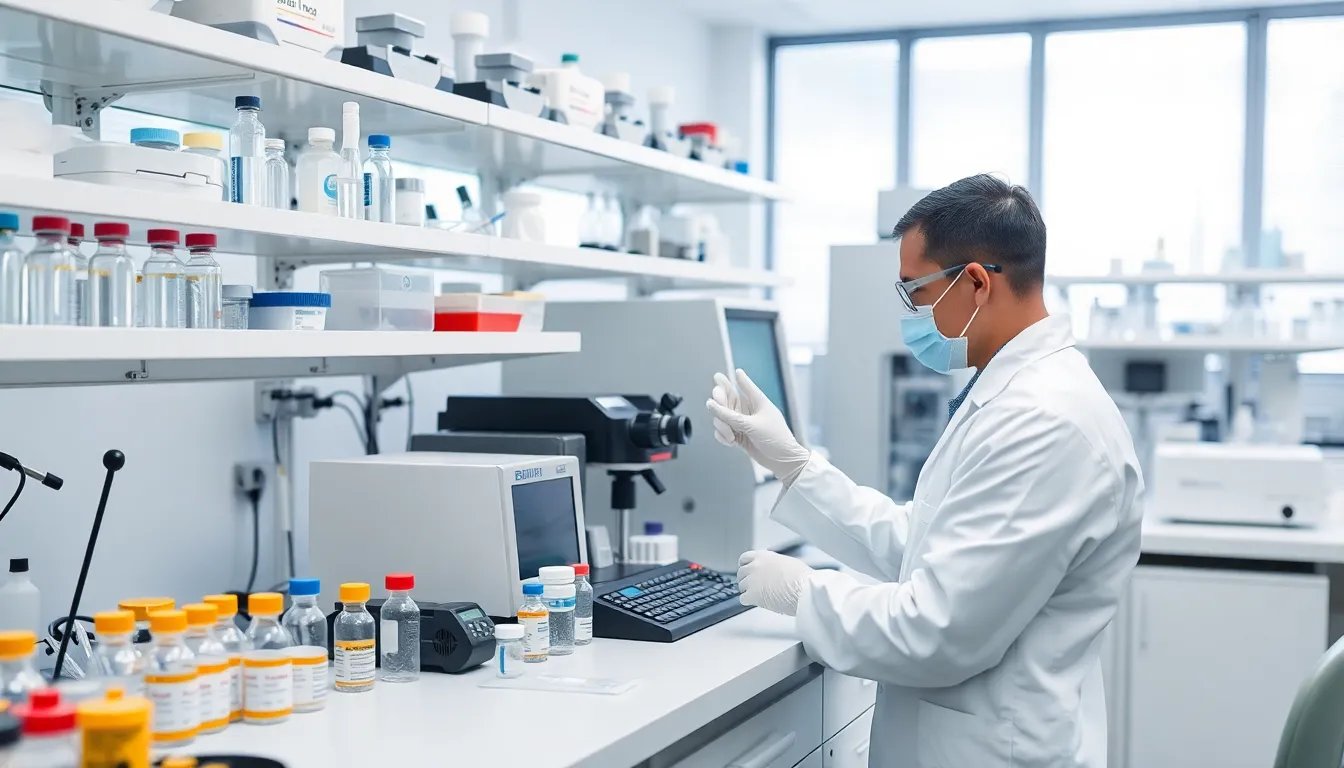In the world of vaccines, batch testing is like the ultimate quality control superhero, swooping in to save the day. Imagine a lab filled with scientists in lab coats, armed with pipettes and a sense of purpose. They’re not just mixing potions; they’re ensuring that every dose is safe, effective, and ready to fight off those pesky viruses.
Batch testing isn’t just a routine; it’s a vital step in the vaccine production process. It’s where the magic happens, as each batch undergoes rigorous checks to guarantee that it meets the highest standards. With the stakes this high, there’s no room for error. So, let’s dive into the fascinating world of batch testing and discover how it keeps the vaccine supply chain running smoother than a well-oiled machine.
Table of Contents
ToggleOverview of Batch Testing of Vaccines
Batch testing serves as a vital quality control mechanism in vaccine production. It ensures the safety and efficacy of each vaccine dose throughout the production process.
Importance of Batch Testing
Batch testing plays a crucial role in public health by confirming that vaccines meet safety standards. It protects individuals from potential harm and builds trust in vaccination programs. Consistent testing identifies issues early, preventing defective batches from reaching the market. Regular checks safeguard the integrity of the vaccine supply chain. Strict adherence to testing protocols maintains high-quality standards essential for effective immunization.
Key Objectives of Batch Testing
The primary objective of batch testing focuses on verifying vaccine potency. Ensuring every batch delivers the intended immune response is critical. Another objective centers on assessing purity, minimizing the risk of contaminants in the final product. Additionally, testing examines stability, confirming that vaccines remain effective during their shelf life. Regulatory compliance stands as a key goal, where adherence to guidelines from health agencies ensures safety and efficacy.
Methods Used in Batch Testing
Batch testing employs a range of methods to ensure vaccines meet safety and efficacy standards. Each method caters to specific aspects of vaccine quality.
Analytical Techniques
Analytical techniques play a crucial role in validating vaccine quality. High-performance liquid chromatography (HPLC) identifies and quantifies vaccine components. In addition, enzyme-linked immunosorbent assay (ELISA) measures antigen presence effectively. Mass spectrometry determines molecular composition and structure, providing insights into purity. Vaccines undergo stability testing to assess how different conditions affect their potency over time. These techniques collectively ensure that vaccines remain safe throughout their shelf life.
Quality Control Procedures
Quality control procedures encompass rigorous checks throughout the production process. Batch samples receive multiple assessments to confirm consistency and reliability. Potency testing evaluates vaccine efficacy, ensuring each dose delivers the intended immune response. Tests for sterility verify that vaccines remain free from microbial contamination. Documentation plays a vital role in maintaining traceability of each batch. Regulatory agencies require strict compliance with testing protocols to meet public health standards. These procedures foster trust in vaccination programs, ultimately contributing to community health safety.
Regulatory Framework for Batch Testing
Batch testing of vaccines operates within a stringent regulatory framework, ensuring safety, efficacy, and quality throughout production processes.
Standards and Guidelines
Numerous standards and guidelines govern vaccine batch testing. The World Health Organization sets international benchmarks to facilitate effective vaccine development and regulation. Additionally, the U.S. Food and Drug Administration (FDA) outlines specific requirements for vaccine testing prior to market release. Compliance with the guidelines ensures that manufacturers perform rigorous assessments, including potency, purity, and stability evaluations. Furthermore, adherence to Good Manufacturing Practices (GMP) is mandatory for all vaccine production facilities. These standards serve as the foundation for a consistent approach to quality control, significantly enhancing public confidence in vaccination programs.
Role of Regulatory Agencies
Regulatory agencies play a pivotal role in overseeing vaccine batch testing. The FDA is tasked with enforcing compliance to maintain public health safety in the United States. Agencies like the European Medicines Agency (EMA) ensure that vaccines meet safety and efficacy standards across Europe. Their responsibilities include reviewing testing data and approving vaccine batches before distribution. When a batch fails to meet established criteria, these agencies necessitate corrective actions from manufacturers. Timely interventions help prevent defective vaccines from reaching the market, safeguarding community health. The collaboration between manufacturers and regulatory bodies maintains high standards vital for public trust in vaccination efforts.
Challenges in Batch Testing of Vaccines
Batch testing of vaccines faces several challenges that can impact the overall quality assurance process. Ensuring that each vaccine dose meets safety and efficacy standards remains critical.
Common Issues Encountered
Common issues in batch testing include variability in raw materials, which can affect vaccine consistency. Contamination during production can also compromise vaccine integrity, posing risks to public health. Inadequate documentation often leads to traceability challenges, making it difficult to identify problems early. Insufficient training of personnel may result in errors during testing procedures, further complicating the process. Regulatory compliance hurdles can arise, especially when adapting to evolving standards set by organizations like the FDA and EMA.
Solutions and Best Practices
Implementing best practices helps mitigate challenges in batch testing. Manufacturers should standardize raw material sourcing to ensure consistency across batches. Regular training programs for personnel enhance competence and reduce testing errors. Establishing robust documentation processes improves traceability, allowing for easier identification of potential issues. Utilizing advanced analytical techniques allows for more accurate assessments of potency and purity. Adhering to stringent regulatory guidelines fosters compliance and maintains public trust in vaccine safety and efficacy.
Future Trends in Batch Testing of Vaccines
Innovations and advancements in batch testing of vaccines evolve continuously, targeting improved safety and efficacy. Research collaboration leads to new testing methods that enhance quality control measures.
Innovations in Testing Methods
New testing methods employ advanced techniques like next-generation sequencing and rapid PCR assays. These innovations improve detection of contaminants and assess vaccine stability with increased accuracy. Moreover, synthetic biology plays a role in developing more efficient screening assays, while portable testing devices enable onsite quality assurance. Enhanced automation in testing processes also reduces human error and speeds up batch assessments, making it possible to respond quickly to public health needs.
Impact of Technology on Testing Efficiency
Technology significantly enhances the efficiency of vaccine batch testing. Implementing cloud-based data management systems streamlines documentation, ensuring real-time access to critical testing data. Additionally, artificial intelligence facilitates the analysis of large data sets, providing insights that support decision-making in quality control. Predictive analytics can identify potential challenges early in the manufacturing process, minimizing risks. Integration of digital twin technology allows manufacturers to simulate and optimize processes, further improving testing efficiency while maintaining regulatory standards.
Conclusion
Batch testing stands as a cornerstone in vaccine production ensuring each dose meets safety and efficacy standards. Its rigorous quality control processes not only protect public health but also build trust in vaccination programs. As challenges arise in the testing landscape new technologies and methodologies will continue to evolve enhancing the reliability of vaccines.
The commitment to maintaining high-quality assurance practices is paramount in safeguarding community health. By adhering to regulatory guidelines and embracing innovative solutions the future of batch testing looks promising paving the way for safer vaccines and a healthier population.





